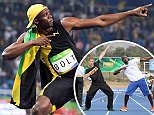Should Caster Semanya be allowed to compete as a woman? Tipped for 800m gold, she has no ovaries, nearly as much testosterone as a man and has sparked a huge ethical debate
- Caster Semenya, 25, a South African runner, is tipped to win the 800m
- But the athlete has ignited a debate about gender at the Olympic Games
- Semenya has testosterone levels three times the normal level in women
- She has no womb or ovaries but rather internal testes due to abnormality
Of all the stars at Rio, few are as hotly tipped for resounding victory as 800m runner Caster Semenya. Fewer still can match her for controversy.
There are those who say she should not be allowed to compete in the Olympics women’s 800m, which she is almost certain to win. No doubt they would also like to see her stripped of her former victories — gold and silver at the 2009 and 2011 World Championships and silver at the London 2012 Olympics.
It is not accusations of doping that dog the South African, though it does come down to chemistry. The question is whether she is, in fact, a biological woman.

South African Caster Semenya has sparked a big ethical debate at the Olympic Games
Semenya, 25, has testosterone levels three times the normal level found in women and approaching those of a man. Furthermore, she has no womb or ovaries, and instead, owing to a chromosomal abnormality, internal testes.
As a result, her appearance is startlingly masculine: her face and physique bring to mind the likes of those East German female hammer throwers of the Sixties and Seventies, whose young bodies were irredeemably masculated by cruel state-sponsored doping programmes.
Though such figures were often the subject of jocularity here in the West, these women’s lives were ruined and often shortened. And just as we should tread carefully when discussing such cases, we should also treat that of Caster Semenya with sensitivity.
It is clearly not her fault she has the condition hyperandrogenism, which causes her body to produce and absorb an excessive amount of male hormones. Though Semenya, as is her right, identifies herself in societal terms as a woman, many in the world of medicine would describe her as intersex or a hermaphrodite.
So with a physique more typically masculine than feminine, is it fair to allow Semenya to compete as a woman? This awkward question must be asked for her presence in the women’s competition presents ethical dilemmas.
One might feel that inclusivity — that she be allowed to compete — is the only rightful expression of the Olympic spirit.
But the reality is that while Semenya, with her excessive levels of testosterone, is allowed on to the track, any rival who raised her levels of the hormone through doping to match the South African’s would be banned.
Then there is the problem as to how, exactly, men and women should be divided for their separate sporting events when not everyone falls tidily into those two categories.
In a society where there are increasing calls for sex and gender to be viewed as being on a spectrum rather than falling into two camps, it is no wonder the world of sport, with its neat division of athletes for male and female events, struggles to navigate such complexities.
If Semenya were not allowed to compete in the women’s events, she would be discriminated against for a condition that is not her fault. But if she does compete, the fear is that it opens the doors for scores of intersex athletes to dominate female sport.

Semenya, 25, competing in the London Olympics, has testosterone levels three times the normal level found in women and approaching those of a man
Indeed, some have suggested this is already happening.
‘I believe that it is not unreasonable to suggest that half of the eight-woman 800m final in Rio might well be intersex,’ says Joanna Harper, a medical physicist and a member of a panel that advises the International Olympic Committee on gender issues.
‘And it is not unlikely that three presumably intersex women will sweep the podium.’
As the arguments swirl, a young athlete’s dreams are in the balance.
In 2011, the world of athletics thought it had answered these questions when the International Association for Athletics Federations (IAAF) issued regulations that stipulated female athletes with excessive testosterone should take drugs to lower their levels to a female range or stop competing.
T he measures were brought about largely in response to Semenya, whose utter domination of the 800m at the 2009 World Championships caused her right to compete to be reviewed.
What followed that competition had been a farce, in which Semenya was subjected to medical examinations, the results of which were leaked to the Press — which is why we know about her internal testes.
‘I’ve been subjected to unwarranted and invasive scrutiny of the most intimate and private details of my being,’ Semenya protested.
South African politicians said they were ‘appalled’ by how sporting authorities had handled the young athlete from a poor village in the north of the country.
In the aftermath, she was given an awkward makeover by a magazine that boasted it had turned ‘SA’s power girl into a glamour girl — and she loves it!’, as she posed in jewellery, make-up and a dress.
‘God made me the way I am and I accept myself,’ she told the magazine — but privately she was said to have been shattered by the ordeal.
In order to avoid such humiliations being repeated on others, the IAAF decided to judge a person’s right to compete in female events by the body’s level of testosterone.
For a while, the system seemed to work and even Semenya accepted it and started taking drugs to lower her testosterone.

South African politicians said they were ‘appalled’ by how sporting authorities had handled the young athlete from a poor village in the north of the country
The result was predictable. Under the new regime, her times started getting slower as her muscle mass began to reduce.
By the London Olympics, she was nowhere near her personal best. Nevertheless, if Semenya thought the system penalised her, she did not complain openly. However, there was one athlete who did. Her name is Dutee Chand, an Indian sprinter who, like Semenya, is hyperandrogenic.
Believing the IAAF’s rules to be unfair, she and the Indian government appealed to the Court of Arbitration for Sport.
In July last year, the Court suspended the IAAF’s regulations on the grounds there is insufficient evidence to link hyperandrogenism to improved performance.
Though, now that the upper limit for female non-drug induced testosterone levels has been removed, it has made a difference to Semenya.
Freed from having to reduce her testosterone, Semenya is back at the top of her game. In Monaco last month, she posted a new personal best of one minute 55.33 seconds, which makes her the 11th fastest woman ever to run the 800m.
In her personal life, she appears to have found happiness, studying for a sports science degree and marrying her long-term girlfriend.
She is understandably reluctant to be drawn into the furore around her gender.
‘I don’t have time for that,’ she said in June. ‘I am an athlete and I focus more on the issues that concern me: training, perform, eat, sleep. So that thing — you know, it’s not part of me.’
But it is possible that over the next few days in Rio, Semenya may beat the world record of one minute and 53.28 seconds, set in 1983 by Czech athlete Jarmila Kratochvilova — whose masculine physique often led her to be accused of doping.
If Semenya does it will prompt more questions. Some argue it is not for the world of sport to decide what is natural about our bodies or to coerce people into medical programmes to alter themselves.
After all, male athletes with naturally excessive testosterone are not forced to medicate.
On the other hand, if testosterone levels like Semenya’s are allowed, what then makes it unacceptable for another female athlete to raise hers artificially to match them?
Regardless of whether or not she identifies herself as a woman, Semenya enjoys a physical advantage over her competitors.
‘When we talk about it in terms of fully expecting no other result than Caster Semenya to win that 800m (at the Olympics), then it’s no longer sport and it’s no longer an open race,’ former British world champion Paula Radcliffe has said.

Semenya has no womb or ovaries, and instead, owing to a chromosomal abnormality, internal testes
Another former world champion, Ireland’s Sonia O’Sullivan, wrote in her newspaper column: ‘It’s through no fault of their own that these (intersex) athletes have been born with more male genes and hormones than female, but this doesn’t mean they can simply be classified as women and allowed to take part in women’s events.’
For the time being, the system is on the side of Semenya. But as the questions raised are bigger than the sporting world, they look likely to remain unresolved.
A similar dilemma is posed by the inclusion of transgender athletes. At the Rio games, a landmark decision by the International Olympic Committee means that transgender men — who were born biologically female — are allowed to compete in the male categories, with no restrictions.
And transgender women — born biologically male — can compete as women providing their testosterone levels are comparable with a ‘cisgender’ woman (cisgender means someone whose gender identity matches the biological sex they were born).
Previously, a transgender woman must have had sex reassignment surgery before they were eligible to compete. However, ‘cisgender’ female athletes may feel they are at a disadvantage compared with an athlete who was born a man.
In the meantime, perhaps we should remind ourselves of the fourth principle of the Olympic Charter: ‘Every individual must have the possibility of practising sport, without discrimination of any kind and in the Olympic spirit, which requires mutual understanding with a spirit of friendship, solidarity and fair play.’
Ultimately, we need to ask: is Caster Semenya playing as fair as she humanly can?
Most watched News videos
-
 Farmers' Almanac predicts a teeth shattering 'ice cold'...
Farmers' Almanac predicts a teeth shattering 'ice cold'...
-
 'Easy Amber' and 'Billy Bob': Johnny Depp sliced off tip of...
'Easy Amber' and 'Billy Bob': Johnny Depp sliced off tip of...
-
 ‘She’s more interested in her bottom than diving!’ Swimmer...
‘She’s more interested in her bottom than diving!’ Swimmer...
-
 Throwback to the Summer of Love: Legendary rock photographer...
Throwback to the Summer of Love: Legendary rock photographer...
-
 Should Caster Semanya be allowed to compete as a woman?...
Should Caster Semanya be allowed to compete as a woman?...
-
 Dramatic moment a zookeeper is saved from a charging leopard...
Dramatic moment a zookeeper is saved from a charging leopard...
-
 Rio resident spots a SEVERED LEG floating in the water just...
Rio resident spots a SEVERED LEG floating in the water just...
-
 Simone STUMBLES! Biles fails to win her fourth gold in Rio...
Simone STUMBLES! Biles fails to win her fourth gold in Rio...
-
 'It was a full on wrestling match!' French silver medallist...
'It was a full on wrestling match!' French silver medallist...
-
 'I want to build my family with Nicole': Dedicated dad...
'I want to build my family with Nicole': Dedicated dad...
-
 Bodycam footage 'proves cop was RIGHT to shoot armed man...
Bodycam footage 'proves cop was RIGHT to shoot armed man...
-
 'I have some cuts and bruises, a few burns... it hurts':...
'I have some cuts and bruises, a few burns... it hurts':...


















































































































































































































































































































































































